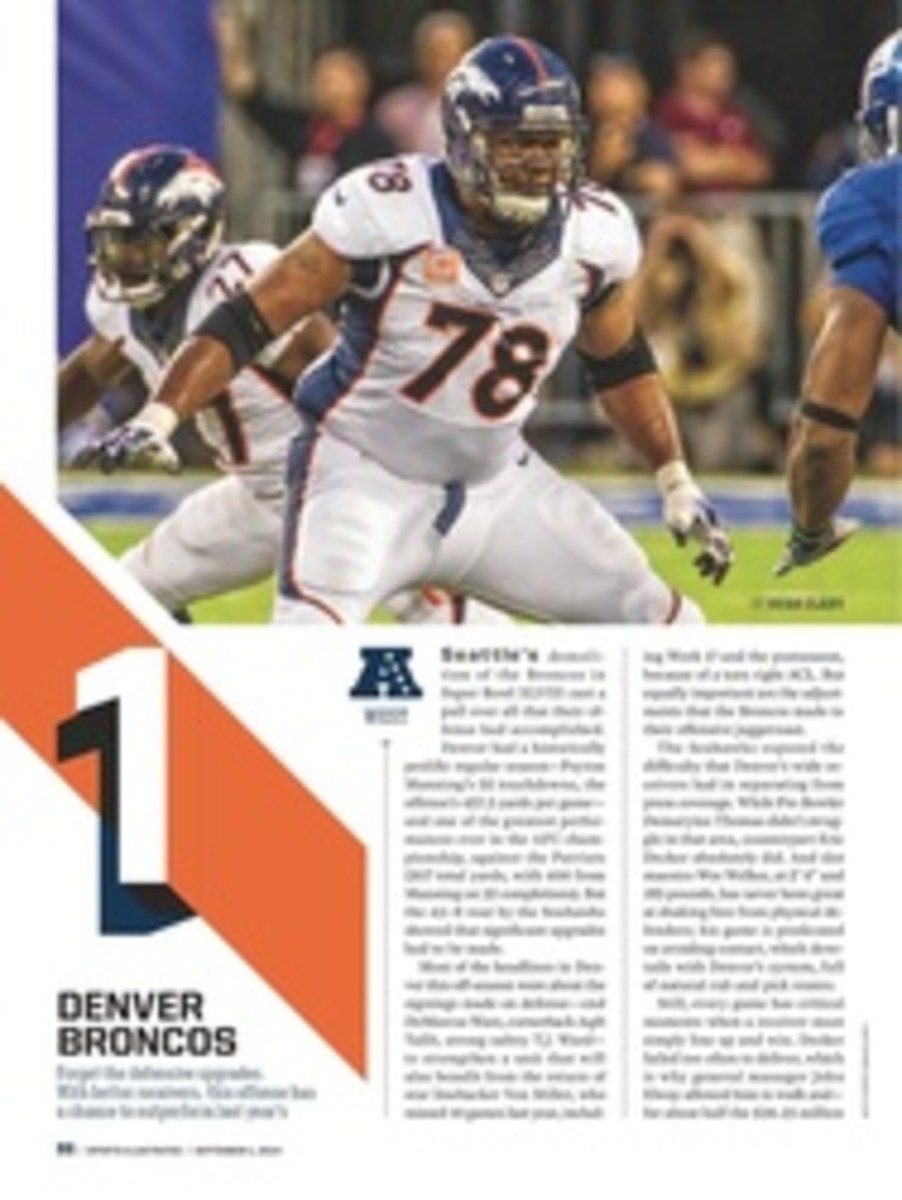
1 GREEN BAY PACKERS
A question that every NFL coach is grappling with these days: Just how important is the ground game?
It's not just that the NFL rule book has become more favorable to passers; it's also that the proliferation of unconventional defensive fronts has made it harder on runners. While generally viewed as a pass-rushing tactic, a hybrid or amoeba defense makes blockers' assignments hard to identify—and indecision is a deadly sin in run-blocking, where the point is to create angles and lanes through collective timing and force. Instead of trying to figure out complicated run-blocking assignments, many offensive coordinators find it easier to use quick-strike throws or deep play-action shots on early downs.
Coach Mike McCarthy knows all about this. His West Coast spread system is on the cutting edge of three-step passing. But last season, when quarterback Aaron Rodgers (a master of this offense) was sidelined for seven weeks with a broken left collarbone, McCarthy had to lean more on his rushers.
In doing so, he discovered that he has a bell-cow back in 5'11", 230-pound Eddie Lacy. The 61st pick in last year's draft out of Alabama averaged a stalwart 18.5 carries and 80.8 yards during Rodgers's absence. Capitalizing on Lacy's patience, the Packers wisely installed a bundle of shotgun tosses, getting the ball into Lacy's hands earlier and deeper behind the line, allowing him to set up blocks rather than rely on initial quickness, which he doesn't have.
When Rodgers returned, McCarthy maintained the balance between the run and the pass. That may have been an effort to help his QB, who was never entirely comfortable post-injury; it was certainly an effort to help Green Bay's mediocre offensive line. Defenders who must be mindful of the run can't simply pin their ears back and attack blockers.
That kind of help will be needed again. Though left tackle David Bakhtiari improved late in his rookie year, he still can't be fully trusted to spar with elite edge rushers. Neither can Bryan Bulaga, who'll return from a torn left ACL and start at right tackle.
By staying balanced, not only will the Packers have a rushing attack that opponents must respect, but they can also implement more of their passing concepts out of running formations. This naturally means an increase in play-action and chip blocks, two tactics that aid an overmatched O-line.
Still, McCarthy, with a healthy superstar at quarterback, will be strongly tempted to spread out and revert to the air. Rodgers is a sharp presnap decision maker, capable of getting rid of the ball quickly. He also has an unmatched ability to make plays after his protection breaks down and a sweet arsenal of playmakers at his disposal. Jordy Nelson, a back-shoulder-catching maestro, emerged as a slot weapon last season while Randall Cobb missed 10 games with a broken right fibula. Cobb, who previously filled the slot role, is at full strength, providing tremendous formation flexibility. Defenses could see Nelson aligned in the slot and Cobb in the backfield in 2014. Such an array would all but guarantee that a linebacker has to pick up one of those playmakers. Advantage, Pack.
Rounding out the receiving corps, 24-year-old Jarret Boykin sharpened his awareness and route running when forced into the lineup last season, though not enough to dissuade GM Ted Thompson from drafting Davante Adams (Fresno State) in the second round. One of those two will fill the No. 3 role vacated by James Jones, who signed with the Raiders in free agency.
In the third round Thompson tabbed tight end Richard Rodgers (California), who, if in shape, will have a chance to complement Andrew Quarless, a fifth-year pro who performed well during Jermichael Finley's prolonged absences. Quarless is not a great in-line run blocker, which means McCarthy may have to employ a heavier formation that includes fullback John Kuhn when he wants to establish the run.
The problem, of course, is that Rodgers could convert 12 sensational third-and-longs, but if he gets hurt on the 13th, none of that matters. And it would be difficult for Green Bay to survive his prolonged absence again. Keep in mind: Though they finished atop the NFC North last year, the Packers were 2-5-1 in games Rodgers didn't finish.
All of which gives McCarthy a lot to think about—but the good thing is, almost all his options are appealing. If something doesn't work in the running game, he can trust his quarterback and receivers to bail him out. That's the luxury of having talent.
2014 SCHEDULE
2013 Record: 8-7-1
WEEK 1
SEA THUR [AWAY]
NYJ [HOME]
DET [AWAY]
CHI [AWAY]
MIN THUR [HOME]
MIA [AWAY]
CAR [HOME]
NO [AWAY]
BYE
CHI [HOME]
PHI [HOME]
MIN [AWAY]
NE [HOME]
ATL MON [HOME]
BUF [AWAY]
TB [AWAY]
DET [HOME]
WEEK 17
KEY CONCEPT
Improvisation
When, inevitably, the offensive structure breaks down, playmakers take over. Aaron Rodgers is as good as any QB in the league—maybe ever—at ad-libbing. He keeps his eyes downfield, uses his mobility to elude rushers and, most important, employs that sterling right arm to make throws from awkward angles and through tight windows. Jordy Nelson is Green Bay's top receiver, but Randall Cobb is Rodgers's go-to guy when a play's structure disappears. A shifty athlete, Cobb has an innate ability to work himself open late in the down. And, like his quarterback, he knows how to improvise. A perfect example: Cobb's game-winning 48-yard touchdown catch at Chicago in Week 17. On that crucial fourth-and-eight play, he appeared primed to run a short route but cut upfield when he noticed the Bears' blown coverage, trusting that his quarterback would see the same thing. Between Rodgers and Cobb, that knack for improvising will carry the Pack in a pinch.
THE CASE FOR
Cornerback Sam Shields
While Green Bay fans are psyched about the arrival of defensive end Julius Peppers, the re-signing of Shields means much more. GM Ted Thompson paid heavily to keep him—$39 million over four years—because the undrafted fifth-year pro has become a pillar of the Packers' D. Coordinator Dom Capers is a founding father of the zone blitz, but in recent years he has concocted new pressure concepts, some involving six rushers instead of a blitz's usual five. To execute these he needs his corners to play tight man, and Shields has developed into one of the league's premier boundary corners. Last season he pressed against A.J. Green, Calvin Johnson, Brandon Marshall, DeSean Jackson and Dez Bryant. He doesn't always win these matchups, but his competitiveness in these pairings allows Capers to be more aggressive in deploying his other defenders. Expect more man coverage from Green Bay in 2014. Number 2 corner Tramon Williams is capable inside or outside. Casey Hayward, a ball hawk as a rookie in '12, is healthy after last year's hamstring problems and will fill the slot. Davon House would be a No. 2 press corner for most teams. And all of them get more favorable matchups because Shields can take on No. 1 receivers.
PHOTO
ROBERT BECK/SPORTS ILLUSTRATED
WR JORDY NELSON
PHOTO
RONALD MARTINEZ/GETTY IMAGES
NINTEEN PHOTOS

